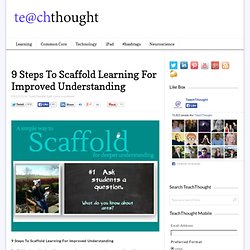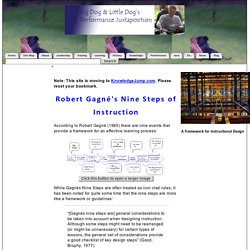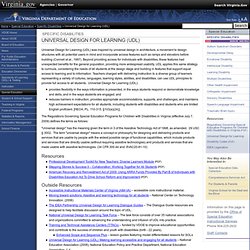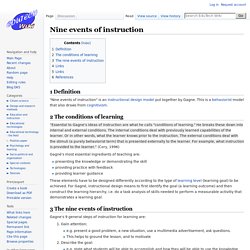

The Best Resources On Differentiating Instruction. My colleague Katie Hull-Sypnieski is leading a February 1st Education Week Webinar on differentiating instruction, and I would strongly encourage people to participate.

Katie’s the best teacher I’ve ever seen…. In addition, Katie and I have co-authored a piece for Education Week Teacher on the topic that will be appearing there soon (it’s appeared: The Five By Five Approach To Differentiation Success), and an upcoming post in my blog there will be talking about it, too (that two part series has also appeared). I also did a second two-part series in Ed Week on differentiation. Also, check out The Best “Fair Isn’t Equal” Visualizations. Given all that, a “The Best…” post was inevitable, and here it is. Here are my choices for The Best Resources On Differentiating Instruction: The Best Places To Get The “Same” Text Written For Different “Levels” Busting Myths about Differentiated Instruction is by Rick Wormeli. 9 Steps To Scaffold Learning For Improved Understanding. 9 Steps To Scaffold Learning For Improved Understanding Scaffolding is a critical teaching strategy that can support students struggling with a concept, or those that have mastered it.

In short, to “scaffold” something is a metaphor that describes the process of supporting students so that they can achieve learning goals in lieu of content deficiencies. Or, in short, helping students succeed. Every student needs a different kind of support, often failing to prove what they know for different reasons–wait time, confidence, reading levels, and so on. The following infographic Mia MacMeekin offers up nine steps that, when followed, represent a scaffolding strategy that can work across grade levels and content areas. It combines independent thinking, visual representation, and collaboration that, while possibly a bit long, represent a versatile approach to scaffolding instruction for students. 1. 2. 3. 4. 5. 6. 7.
UDL Toolkits: Teaching Every Student. The Planning for All Learners (PAL) process builds upon two prerequisites: A basic understanding of Universal Design for Learning, andCommitment of participating educators to make the curriculum and learning accessible for all learners.

The PAL process begins with the formation of the PAL team, comprised of general education and special education teachers and other appropriate educational specialists at one grade level or with a content specific focus. The team meets regularly during the school year to focus on the foundation of instruction — the curriculum. Identification of a strong team facilitator, responsible for scheduling meetings and agenda, providing and/or facilitating "just in time" support, and actively promoting a growing PAL initiative, is essential to the success of the PAL team.
The work of the PAL team must always be aligned with local district and school initiatives, and is guided by state and local curriculum standards. Universal Design for Learning (UDL) Robert Gagné's Nine Steps of Instruction. According to Robert Gagné (1985) there are nine events that provide a framework for an effective learning process: While Gagnés Nine Steps are often treated as iron clad rules, it has been noted for quite some time that the nine steps are more like a framework or guidelines: “[Gagnés nine steps are] general considerations to be taken into account when designing instruction.

Although some steps might need to be rearranged (or might be unnecessary) for certain types of lessons, the general set of considerations provide a good checklist of key design steps” (Good, Brophy, 1977). The Nine Steps 1. Storytelling Demonstrations Presenting a problem to be solved Identifying why it is important to them Wick, Pollock, Jefferson, and Flanagan (2006) describe how the research also supports extending the interest device into the workplace in order to increase performance when the learners apply their new skills to the job. 2. 3. 4. 5. 6. Universal Design for Learning. Your browser does not support JavaScript!

This site uses JavaScript but is fully functional without it. Specific Disabilities Universal Design for Learning (UDL) was inspired by universal design in architecture, a movement to design structures with all potential users in mind and incorporate access features such as ramps and elevators before building (Connell et al., 1997). Beyond providing access for individuals with disabilities, these features had unexpected benefits for the general population, providing more widespread usability.
UDL applies this same strategy to curricula, considering the needs of all students at the design stage and building in features that support equal access to learning and to information. The Regulations Governing Special Education Programs for Children with Disabilities in Virginia (effective July 7, 2009) defines the terms as follows: "Universal design" has the meaning given the term in 3 of the Assistive Technology Act of 1998, as amended. 29 USC § 3002.
Nine events of instruction. 1 Definition "Nine events of instruction" is an instructional design model put together by Gagne.

This is a behaviorist model that also draws from cognitivism. 2 The conditions of learning “Essential to Gagne's ideas of instruction are what he calls "conditions of learning. " He breaks these down into internal and external conditions. Gagné's most essential ingrediants of teaching are: presenting the knowledge or demonstrating the skillproviding practice with feedbackproviding learner guidance.